"An endeavour to preserve some memorial of the brilliant and fugitive beauties, of a particularly splendid and elegant tribe of plants, first gave rise to this work; and having enjoyed considerable, perhaps unusual, advantages, in the very great liberality with which specimens were supplied, both from public, and private collections, it became a favourite recreation, to describe them as simply and naturally as possible, with both pen and pencil.
Having no pretensions whatever, either to scientific knowledge, or extensive research, any attempt at a lengthened technical descriptions, is purposely avoided [...and the artist/author...] relies on the indulgence and courtesy of those more able and learned promoters, or generous admirers of botanical pursuits, who may be induced to patronize the feeble attempts, of an Amateur." [from the preface]

Amaryllis belladonna

Amaryllis correiensis

Amaryllis crocata
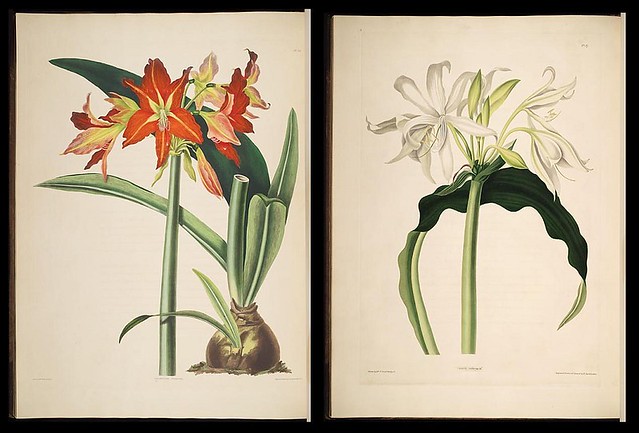
Amaryllis fulgida and Crinum giganteum
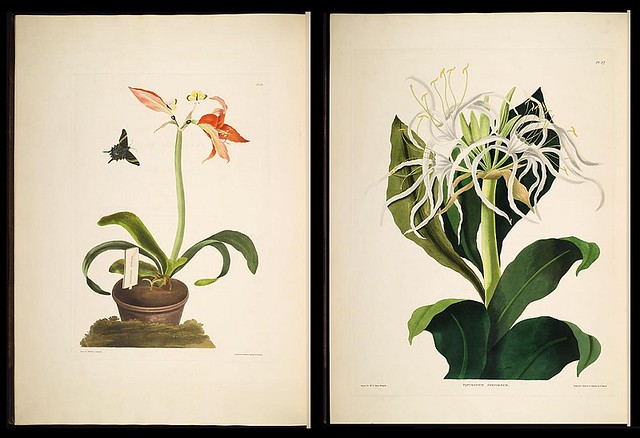
Amaryllis miniata and Pancratium speciosum

Amaryllis psittacina

Amaryllis solandriflora
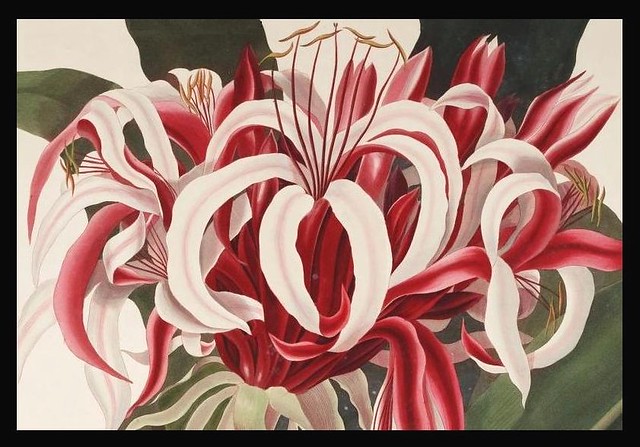
Crinum augustum
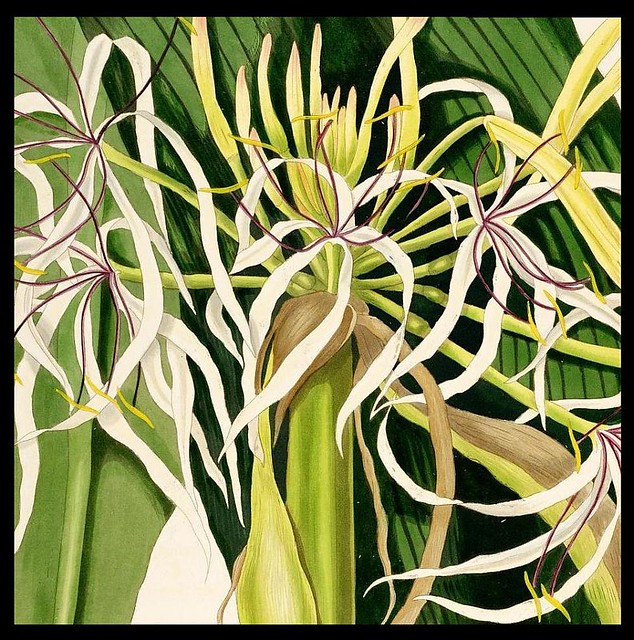
Crinum declinatum
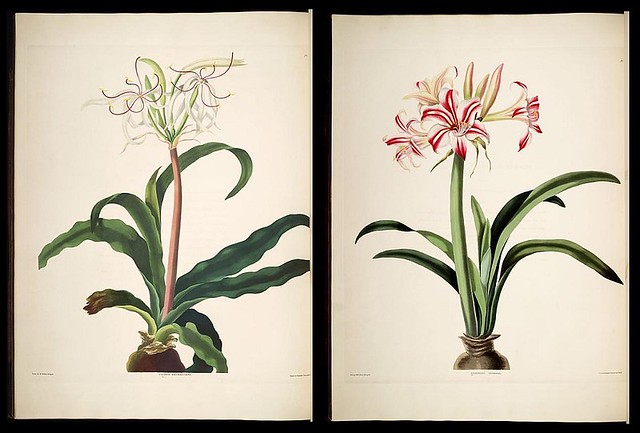
Crinum erubescens and Amaryllis superba
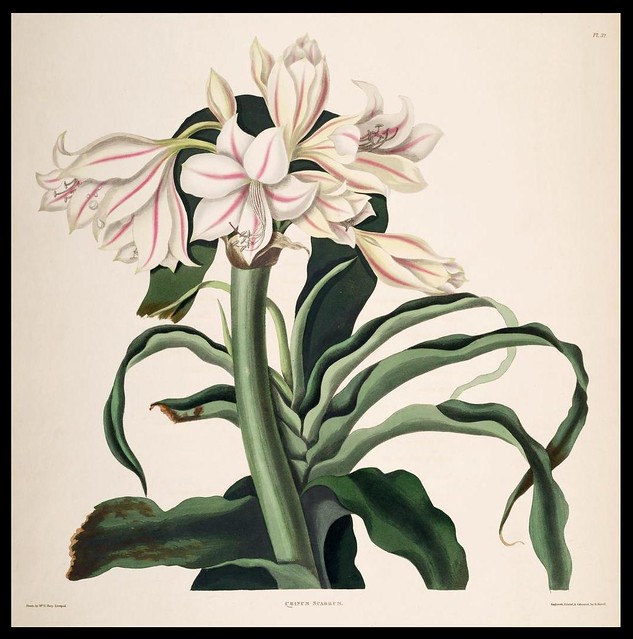
Crinum scabrum

Pancratium amboinense
Priscilla Susan Bury [née Faulkner or Falkner and often cited as 'Mrs Edward Bury'] (~1790s-1869) was a self-taught watercolour artist who sketched exotic plants from her father's greenhouses on their estate near Liverpool, England, where she grew up.
Encouraged by a local botanist, William Rowe, and enlisting the technical expertise of staff at the Liverpool Botanical Gardens to assist with the accompanying text, Bury set about preparing a book of fifty one 'portraits' (as she called them) of her favoured Hexandrian species. These are a Linnean class of plants having six stamens, including lilies, hippeastrums, crinums and pancratiums.
The partially hand-coloured aquatint engravings of Bury's drawings were produced by the workshop of Robert Havell, who were working on the plates for JJ Audubon's extravagant series, 'Birds of America' at the same time. Audubon himself was one of the seventy nine subscribers to Bury's book which was released over three years beginning in 1831. The modest circulation numbers makes Bury's exquisite Hexandrian plant series a very rare and desired botanical publication. Not bad for an Amateur.
The only other works of note I discovered by Priscilla Susan Bury included artistic contributions to Benjamin Maund's 'Botanic Garden' and 'The Botanist' in the 1840s, but years later her drawings of microorganisms, including some Radiolaria, were published in a very early photographic plate book, 'Polycistins'.
'A Selection of Hexandrian Plants, Belonging to the Natural Orders Amaryllidae and Liliacae' is online at Botanicus, the Illustrated Garden, NYPL (easy to see all the plates) or the (new to me) commendable multinational collaborative Biodiversity Library. [all identical, save for the NYPL version]
The detail (as opposed to full page) illustrations above are all spliced together from screencaps and the age-related spotting and text bleed-through has been removed or subdued.
The chain: this post was largely inspired by an entry seen on the Princeton University Graphic Arts Division blog which was found through the Museum Blogs aggregator site which is produced by the Ideum group who are responsible for some significant web projects.
Sources for this entry: i, ii, iii, iv, v.



















8 comments :
These are absolutely gorgeous. Thank you so much for the write-up!
Thanks Sarah.
Roland, it's you. Or at least, we can get symbolic meaning out of anything if we choose to view it that way I suppose.
Roland, it's not you. It's the way the flowers are painted, but they would have looked sexual and slightly alarming in their beauty to the painter, too -- only she wouldn't have thought of it that way. I could go on -- I mean, defend my point of view and amplify on it, but I won't.
What a gorgeous post!
My uncle found an incomplete collection of this (Mrs Bury's amaryllis plates) unceremoniously dumped in a skip, many years ago (along with a five-foot stack of various other prints, watercolours, etchings and amazingly enough, an original set of blueprints of the Brandenburg Gate, Berlin). I dread to think what other treasures had been taken to a landfill or to be burnt before he stumbled across them.
I can assure you that these aquatints are indeed gorgeous - delicious, in fact - with some plates having butterflies that look like they could just fly from the page. From what we were told (back in 1996), there were only two or three complete sets in existence, making them very rare indeed.
Q, what a find by your uncle! Congratulations! However, I think you have been misled by the number of complete sets. I haven't looked in OCLC to check out institutional holdings, but just according to American Book Prices Current (ABPC - prices realised at auctions for books since 1975) 12 copies of Bury's book have been sold. Only one of these (Christie's, June 4, 2001, lot 5, £65,000) was incomplete with only 45 of the 51 plates. The last copy to sell at auction was the Kuse copy at Sotheby's New York, June 20, 2003, lot 4. Rather amusingly there is an error in ABPC (CD-ROM version) that says it was sold for a mere $150 - it should read $150,000 hammer; or, put another way, $176,000 including the Buyer's Premium!
If you've got the money, I know that another copy is coming up for sale at Christie's in London at the end of April.
Pecay, I've got to say that your images are fantastic - much better and clearer than those on Sotheby's website. How do you do it? Keep up the good work!
Marmath - thank you for digging out that info!
It seems the expert did indeed give us misleading information. As I mentioned, this was back in '96 or even possibly early '97. At the time, we were certainly left to believe that there were only a very small number of complete bound sets. I do know that - again, at the time - there was also quite some interest in our set (albeit incomplete) but my uncle would never consider selling them and has since then, squirreled them away.
Apologies if it appears I have hijacked the comments for this post, but not having thought about the aquatints for some time (they're too cumbersome for my uncle to keep at hand, so they're under lock and key) it was such a surprise (and delight) to see them posted up on a blog I regularly visit and enjoy. So my thanks to peacay for pointing them out - I can now look at the illustrations online, without being scrutinised in case I breathed too heavily or left dirty fingerprints on them!
Lovely. If these are feeble attempts we look forward to the more accomplished works you uncover for us this year.
Indeed, that's a great story Q and I would be taking care to be nice to my potentially philanthropic uncle.
If you happen to remember marmath, when the auction is on, I'd be obliged if you would let me/us know. I only rarely and haphazardly scan auction pages. (and a lot of work went into preparing the images here: a few hours at least. Sothebys could not afford me as an indulgence)
M&J, I imagine I could post something botanical every single day for a couple of years before I was anywhere near scraping the bottom of the aesthetic barrel. It's a very rich vein and I try to pace myself. I have in mind some Central American orchids next I seem to recall (I quickly scan links and save them before diving in later for the download and cropping/presentation chores)
Post a Comment
Comments are all moderated so don't waste your time spamming: they will never show up.
If you include ANY links that aren't pertinent to the blog post or discussion they will be deleted and a rash will break out in your underwear.
Also: please play the ball and not the person.
Note: only a member of this blog may post a comment.